In Alabama, a rich tapestry of avian life unfolds against the backdrop of diverse landscapes. Eleven distinct hawk species call this southern state home, elevating the skies gracefully and powerfully.
From the iconic Red-tailed Hawk to the elusive Northern Harrier, these raptors embody the essence of Alabama’s wild expanses.
This exploration unveils the remarkable world of 11 Hawks in Alabama, offering insights into their unique features, habitats, and vital roles within the intricate ecological web.
With varying sizes, behaviours, and habitats, these hawks collectively contribute to the dynamic biodiversity of Alabama, showcasing the state’s commitment to preserving its natural heritage.
Join us on a journey through the skies, delving into the lives of these magnificent birds that epitomize the spirit of the Alabama wilderness. Stay focused.
11 Hawks in Alabama
Find out the diverse avian residents of Alabama with this concise guide to hawks.
From the majestic Red-tailed Hawk to the elusive Northern Harrier, discover the unique characteristics and lifestyles of these remarkable birds soaring through the skies of the Yellowhammer State.
So, let’s delve into the characteristics and lifestyles of each hawk species in Alabama:
1. Red-tailed Hawk
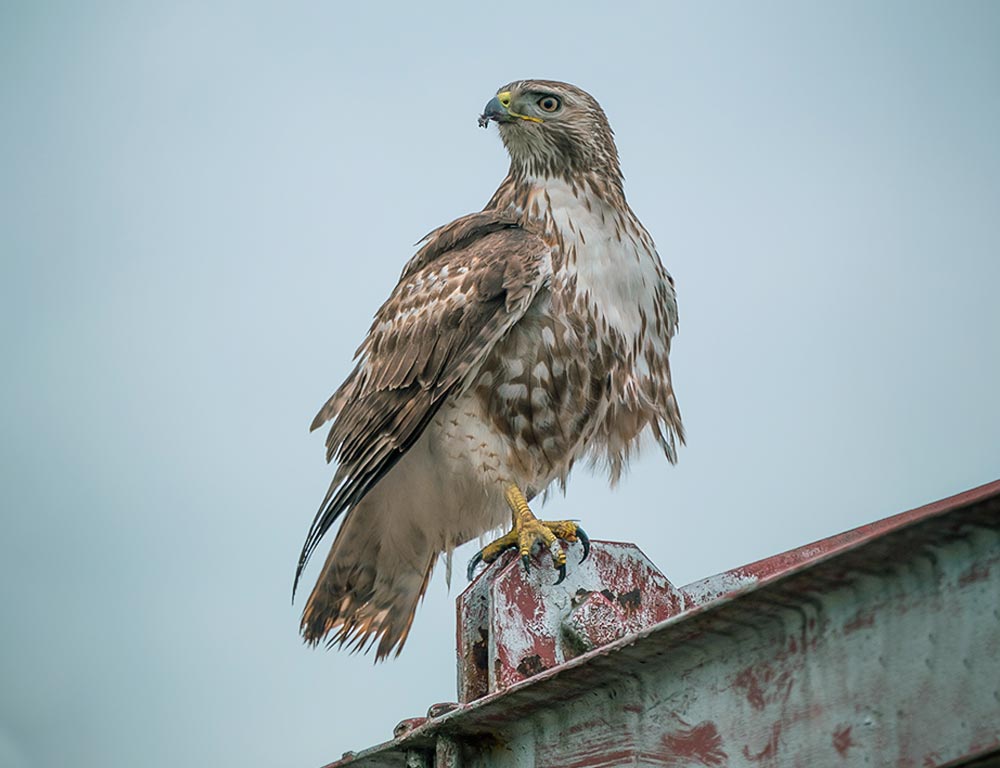
- Scientific name: Buteo jamaicensis
- Life span: 10-20 years
- Size: 18-26 inches
- Weight: 1.5-3.5 pounds
- Food: Mainly small mammals, birds, and reptiles
- Wingspan: 43-57 inches
- Status: Common and widespread
Red-tailed Hawks (Buteo jamaicensis) are one of the most recognizable raptors in Alabama.
These hawks are characterized by their striking reddish-brown tails, which are often visible in flight. They are broadly distributed across various habitats, from forests to open fields.
Red-tailed Hawks are opportunistic hunters, preying on small mammals like rodents, rabbits, and squirrels. They also feed on birds and reptiles.
With excellent eyesight, they hunt from perches or soar high in the sky, using their keen vision to spot potential prey. Known for their adaptability, Red-tailed Hawks can be found in urban areas, farmlands, and woodlands.
They build large nests in trees or on cliffs and often reuse the same nest in subsequent years. These hawks are monogamous and form strong pair bonds.
During the breeding season, Red-tailed Hawks engage in impressive aerial displays, including courtship flights and talon grappling. Their nests, made of sticks and lined with softer materials, are a testament to their resourcefulness.
Red-tailed Hawks are crucial in controlling rodent populations, making them valuable contributors to ecosystem balance. Despite being common, they face threats from habitat loss and human activities.
2. Northern Goshawk
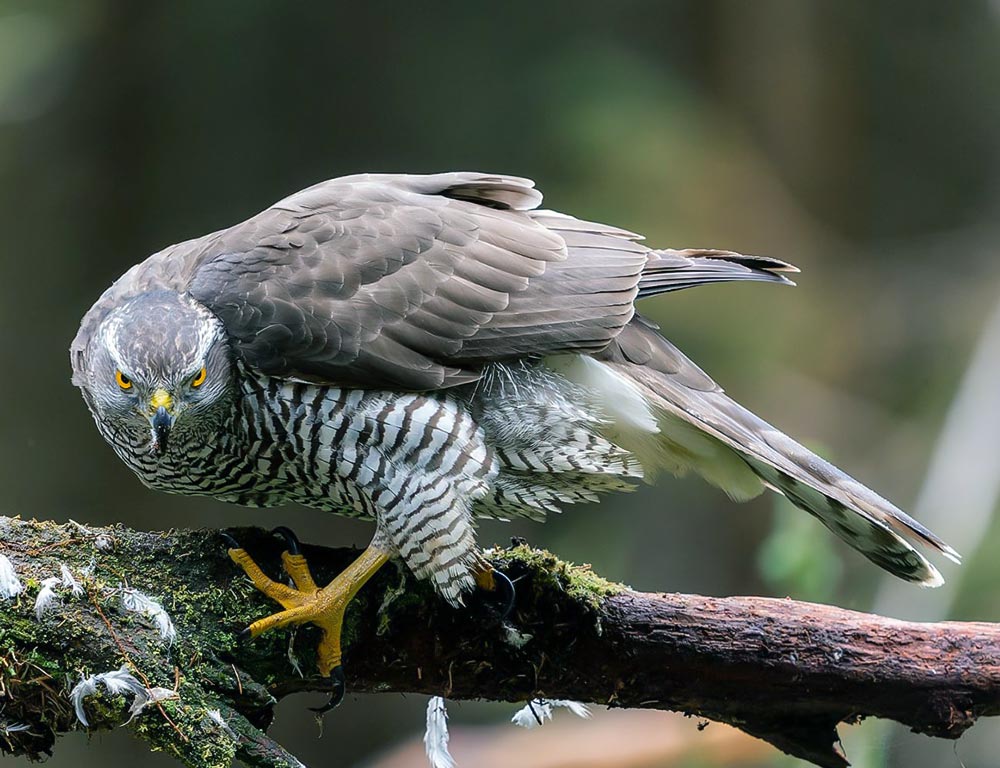
- Scientific name: Accipiter gentilis
- Life span: 8-12 years
- Size: 20-26 inches
- Weight: 1.5-3.5 pounds
- Food: Mainly birds and mammals
- Wingspan: 40-46 inches
- Status: Uncommon, with localized populations
The Northern Goshawk (Accipiter gentilis) is a formidable hawk with a more secretive nature compared to the Red-tailed Hawk. Its habitat preferences include coniferous and mixed forests, and it is known for its agility in flight.
These hawks primarily feed on medium-sized birds and mammals. Their hunting strategy often involves flying swiftly through dense vegetation, surprising their prey with sudden bursts of speed.
Goshawks are adept at capturing birds in flight and pursuing mammals on the ground. Northern Goshawks are known for their aggressive behaviour, especially during the breeding season when defending their territory.
They build large nests in the canopy of trees, constructed with sticks and lined with softer materials. Despite their size, they are agile flyers, easily navigating through dense forests.
Due to their preference for mature forests, Northern Goshawks face challenges from habitat fragmentation and logging activities. Conservation efforts focus on maintaining suitable habitats and ensuring sustainable forestry practices.
3. Ferruginous Hawk
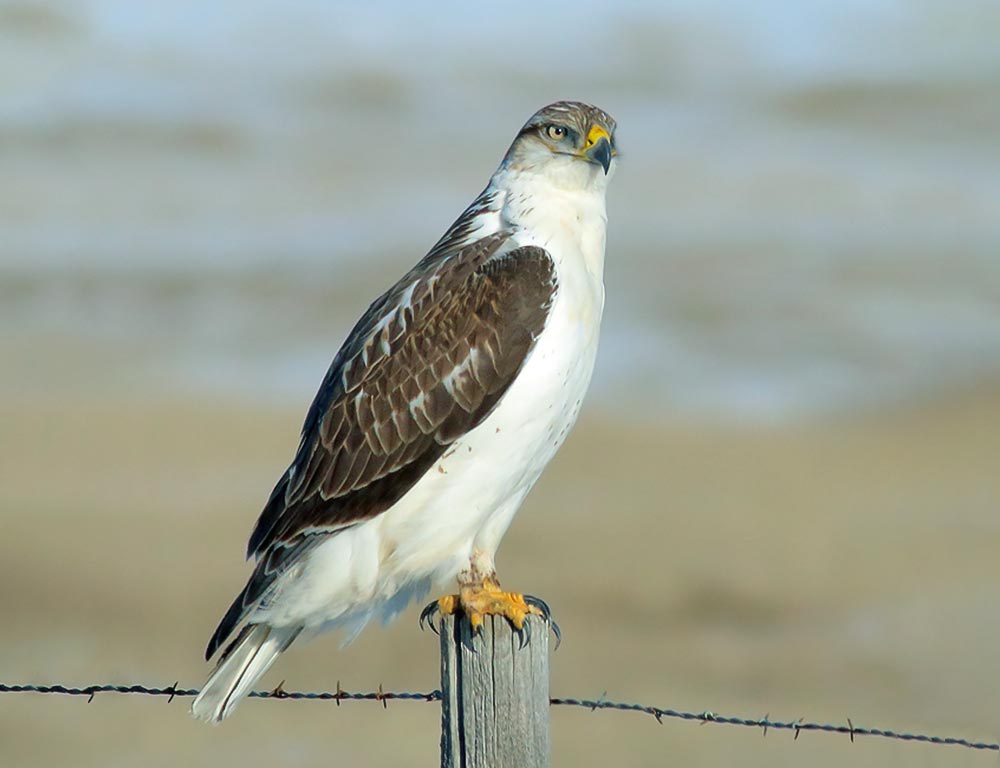
- Scientific name: Buteo regalis
- Life span: 10-20 years
- Size: 22-27 inches
- Weight: 2-5.5 pounds
- Food: Mainly mammals, especially ground squirrels and rabbits
- Wingspan: 49-60 inches
- Status: Declining, with habitat loss and disturbance as key threats
The Ferruginous Hawk (Buteo regalis) is a large and striking bird of prey that prefers open habitats such as grasslands, prairies, and deserts. Named for its rust-colored plumage, this species has faced challenges due to habitat degradation.
Ferruginous Hawks are specialized hunters of ground-dwelling mammals, particularly ground squirrels and rabbits.
Their powerful talons and beaks enable them to capture and consume larger prey items than many other hawks. They often nest on cliffs or low vegetation, constructing large nests with sticks.
These hawks are known for their soaring flight and can cover vast distances while searching for food. Ferruginous Hawks are territorial during the breeding season, and their nests are defended vigorously against intruders.
Conservation efforts for Ferruginous Hawks focus on preserving large, intact grassland habitats and minimizing disturbance during the breeding season.
The decline in their population underscores the importance of addressing threats to their preferred ecosystems.
4. Red-shouldered Hawk
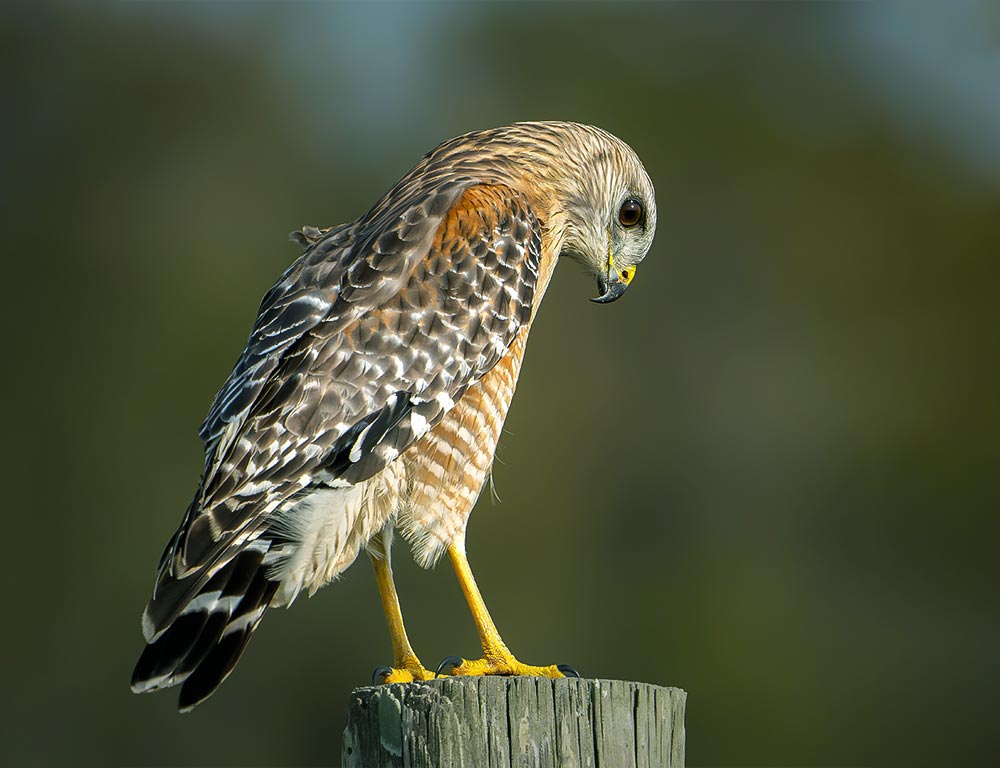
- Scientific name: Buteo lineatus
- Life span: 10-15 years
- Size: 16-24 inches
- Weight: 1-2 pounds
- Food: Mainly small mammals, amphibians, and reptiles
- Wingspan: 37-43 inches
- Status: Common, with stable populations
The Red-shouldered Hawk (Buteo lineatus) is a medium-sized hawk with distinctive reddish-brown shoulders. They inhabit various wooded habitats, including forests, swamps, and riparian areas, making them a common sight in Alabama.
Red-shouldered Hawks have a diverse diet, preying on small mammals like mice and voles, as well as amphibians and reptiles. They are known for their loud and distinctive calls, often heard as they soar above their territories.
These hawks build nests in the canopy of trees, using sticks and lining the nest with softer materials.
They are monogamous and often return to the same nesting site year after year. Red-shouldered Hawks are active hunters, using their sharp talons to capture prey while perched or in flight.
Their populations are generally stable but face habitat loss and fragmentation threats.
Conservation efforts involve preserving and restoring suitable habitats, ensuring the availability of nesting sites, and minimizing human disturbance in their breeding territories.
5. Short-tailed Hawk
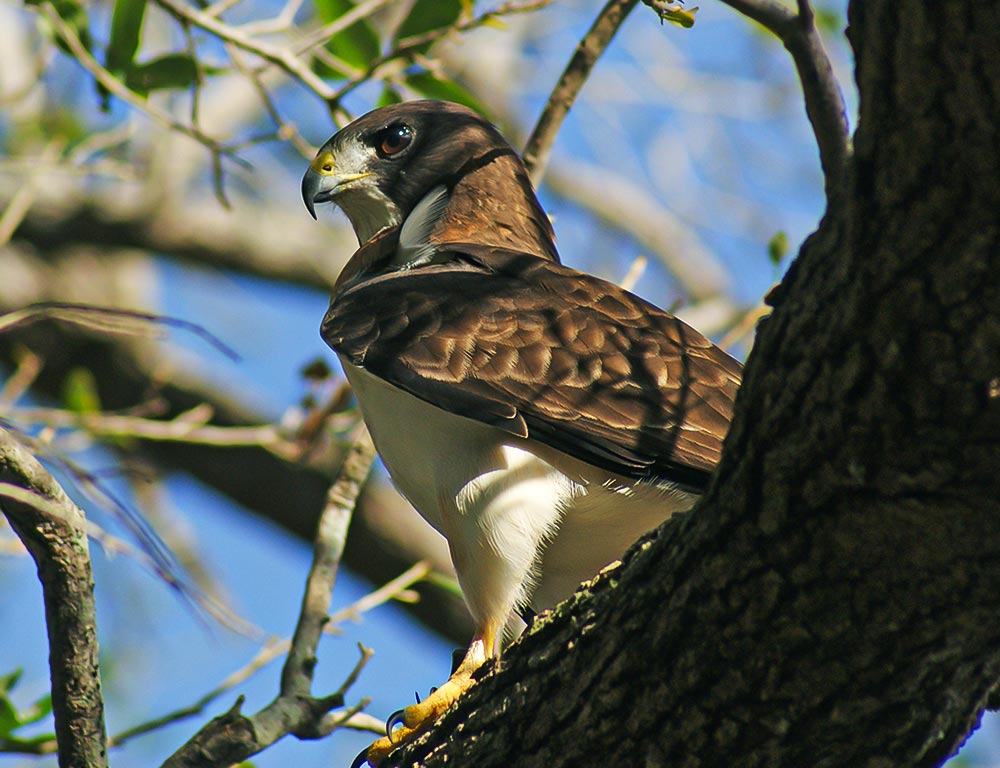
- Scientific name: Buteo brachyurus
- Life span: 5-10 years
- Size: 16-20 inches
- Weight: 0.6-1.2 pounds
- Food: Mainly birds, especially small to medium-sized species
- Wingspan: 35-42 inches
- Status: Uncommon, with localized populations
The Short-tailed Hawk (Buteo brachyurus) is a distinctive raptor with a relatively short tail and a preference for tropical and subtropical habitats.
Found in southern parts of the United States, including Florida, these hawks are known for their aerial acrobatics and agility.
Short-tailed Hawks primarily feed on birds, hunting them in flight. Their short tail enhances their maneuverability, allowing them to navigate dense vegetation in pursuit of prey.
These hawks build nests in tall trees, constructing platforms with sticks. Due to their restricted range and specific habitat requirements, Short-tailed Hawks face habitat loss and human disturbance threats.
Conservation efforts focus on preserving their preferred habitats and raising awareness about the importance of maintaining biodiversity in these ecosystems.
6. Sharp-shinned Hawk
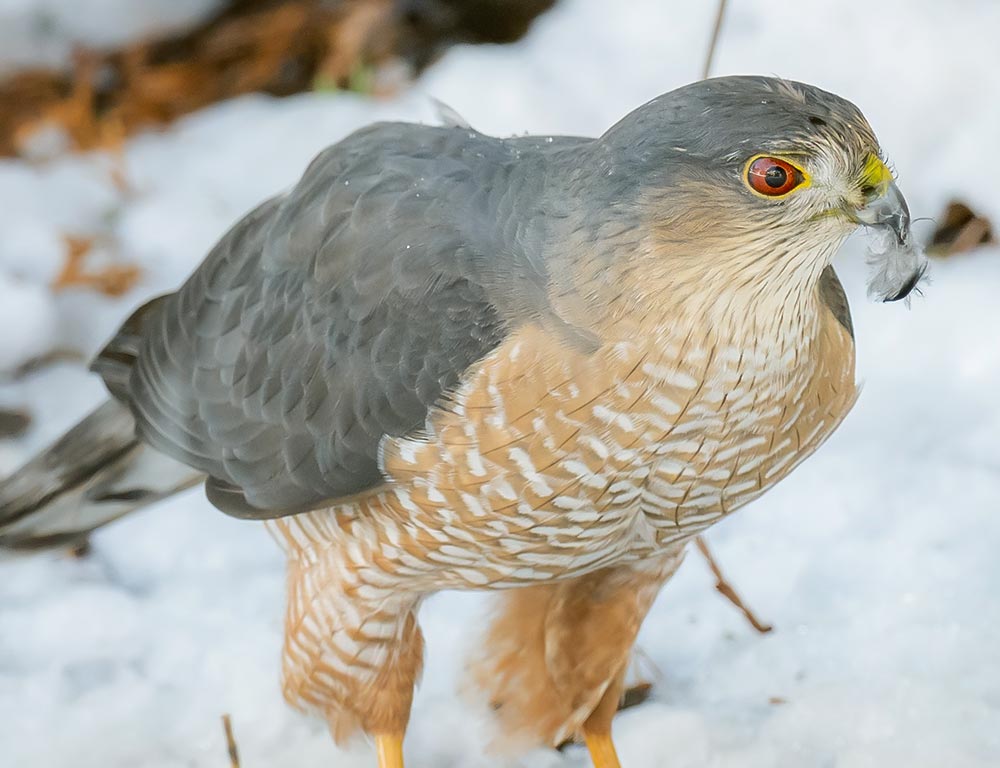
- Scientific name: Accipiter striatus
- Life span: 7-10 years
- Size: 9-13 inches
- Weight: 3-7 ounces
- Food: Mainly birds, especially small songbirds
- Wingspan: 16-22 inches
- Status: Common, with stable populations
The Sharp-shinned Hawk (Accipiter striatus) is a small and agile hawk found in various habitats, including forests, parks, and urban areas. Recognized by its short wings and long tail, this hawk is an adept hunter of small birds.
Sharp-shinned Hawks are known for their rapid flight and stealthy hunting techniques. They use cover and surprise to catch small songbirds in mid-air.
Their nests, constructed with sticks, are often placed in trees. During the breeding season, males perform courtship displays to attract females.
While Sharp-shinned Hawks are common and adaptable, they can face challenges in urban environments due to collisions with buildings and other human-related threats.
Conservation efforts aim to raise awareness about the impact of urbanization on these hawks and promote bird-friendly practices.
7. Cooper’s Hawk
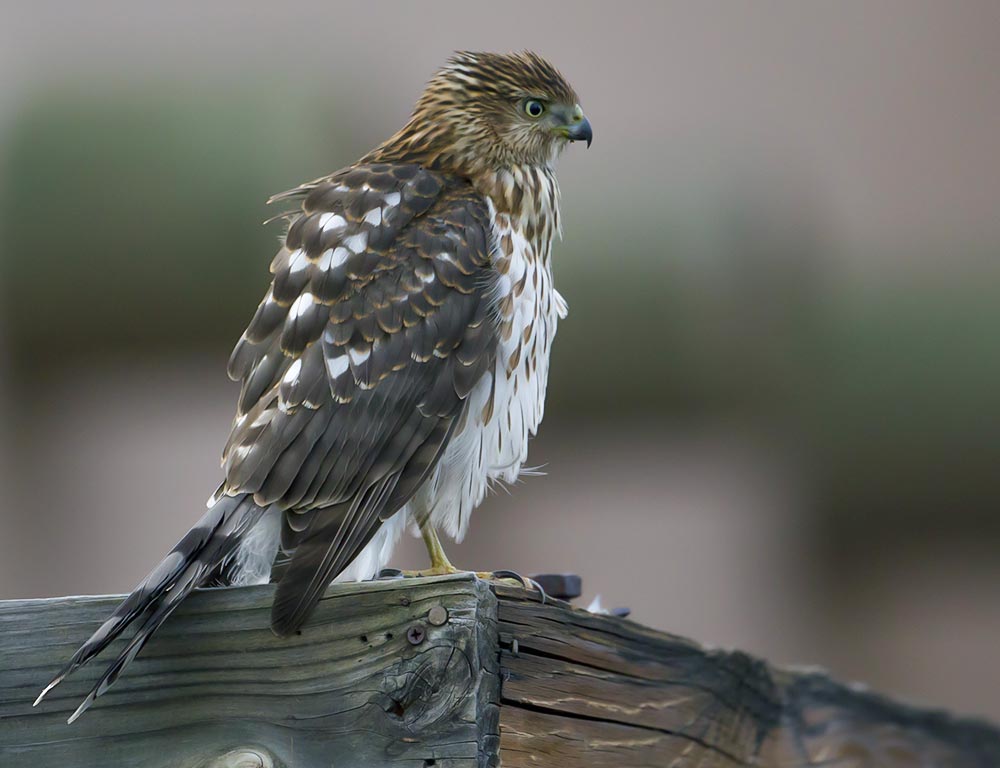
- Scientific name: Accipiter cooperii
- Life span: 7-10 years
- Size: 14-20 inches
- Weight: 0.5-1.5 pounds
- Food: Mainly birds, especially medium-sized species
- Wingspan: 24-35 inches
- Status: Common, with stable populations
The Cooper’s Hawk (Accipiter cooperii) is a medium-sized hawk with a rounded tail and a preference for wooded habitats.
These hawks are versatile hunters, preying on various birds, including pigeons, doves, and small mammals. Cooper’s Hawks are known for their swift flight through dense vegetation while pursuing prey.
They build nests in trees, constructing platforms with sticks and lining them with softer materials. Like the Sharp-shinned Hawk, males engage in courtship displays during the breeding season.
While Cooper’s Hawks are well-adapted to various environments, they face some threats, including habitat loss and potential pesticide exposure.
Conservation efforts involve monitoring their populations, ensuring suitable nesting sites, and promoting the importance of healthy ecosystems for bird species.
8. Rough-legged Hawk
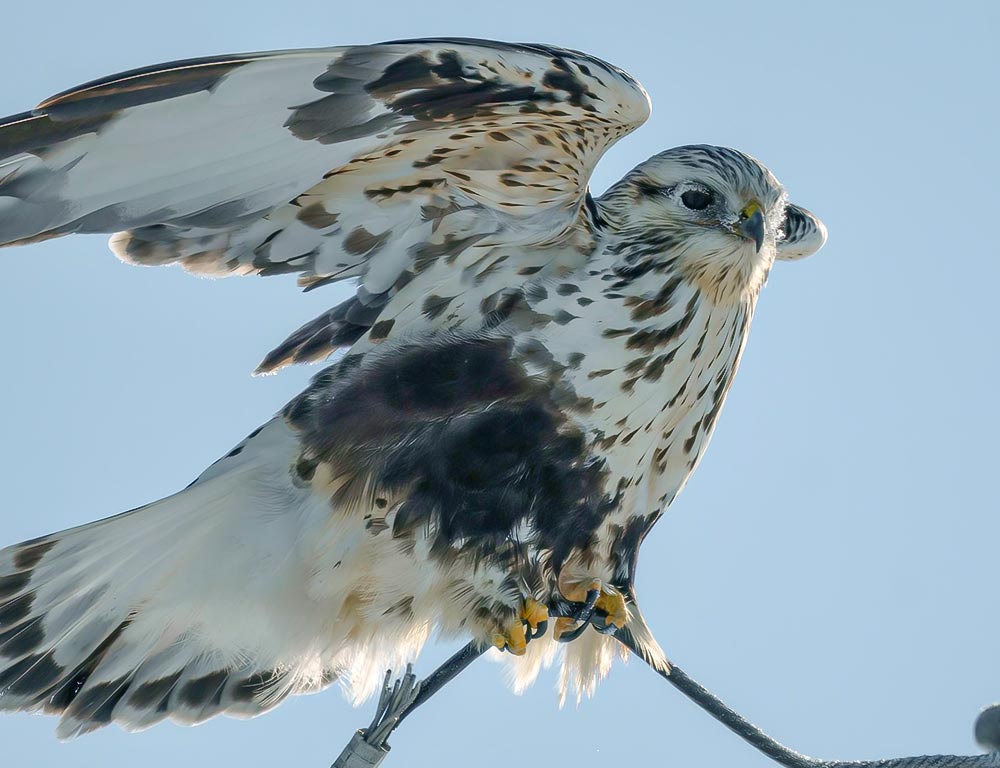
- Scientific name: Buteo lagopus
- Life span: 10-20 years
- Size: 18-24 inches
- Weight: 2-4 pounds
- Food: Mainly small mammals, especially rodents
- Wingspan: 52-54 inches
- Status: Uncommon winter visitor, migratory
The Rough-legged Hawk (Buteo lagopus) is a distinctive raptor known for its feathered legs extending down to its talons. These hawks breed in the Arctic and migrate to southern regions during the winter, occasionally visiting Alabama.
Rough-legged Hawks primarily feed on small mammals, such as voles and lemmings. Their ability to hover and search for prey over open fields is facilitated by their broad wings and keen eyesight.
During the winter, these hawks can be observed perched on poles or in flight, searching for food. While not a common resident, Rough-legged Hawks highlight the importance of open habitats for wintering raptors.
Conservation efforts include habitat preservation and maintaining suitable areas for wintering raptors like the Rough-legged Hawk.
9. Northern Harrier
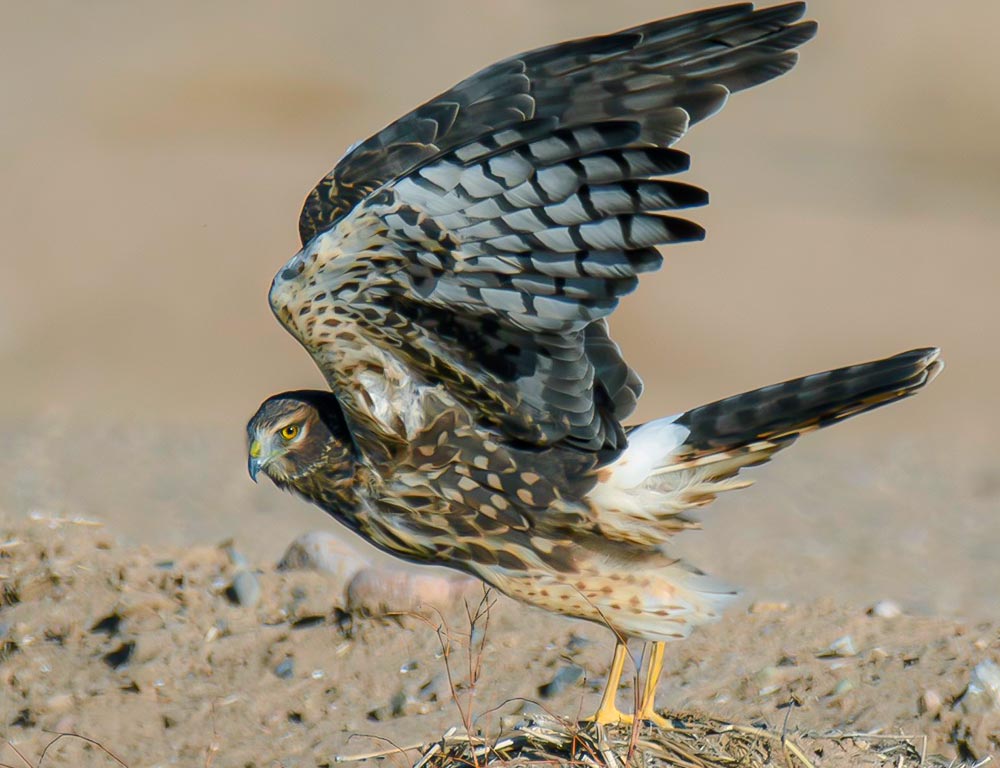
- Scientific name: Circus hudsonius
- Life span: 5-10 years
- Size: 18-24 inches
- Weight: 10-26 ounces
- Food: Mainly small mammals, birds, and insects
- Wingspan: 40-48 inches
- Status: Common, with stable populations
The Northern Harrier (Circus hudsonius) is a slender and long-winged hawk found in various open habitats, including marshes, grasslands, and agricultural fields.
Northern Harriers are skilled hunters known for their distinctive hovering flight and facial disks.
These hawks primarily feed on small mammals, birds, and insects. Northern Harriers use their keen sense of hearing and owl-like facial disk to locate prey in dense vegetation.
They often fly low over fields, marshes, or grasslands, using their long wings to soar and hover. Northern Harriers are ground nesters, building nests in tall vegetation. During the breeding season, males perform acrobatic displays to attract females.
While generally common and adaptable, they can face threats from habitat loss, especially in areas with intensive agriculture.
10. Swainson’s Hawk
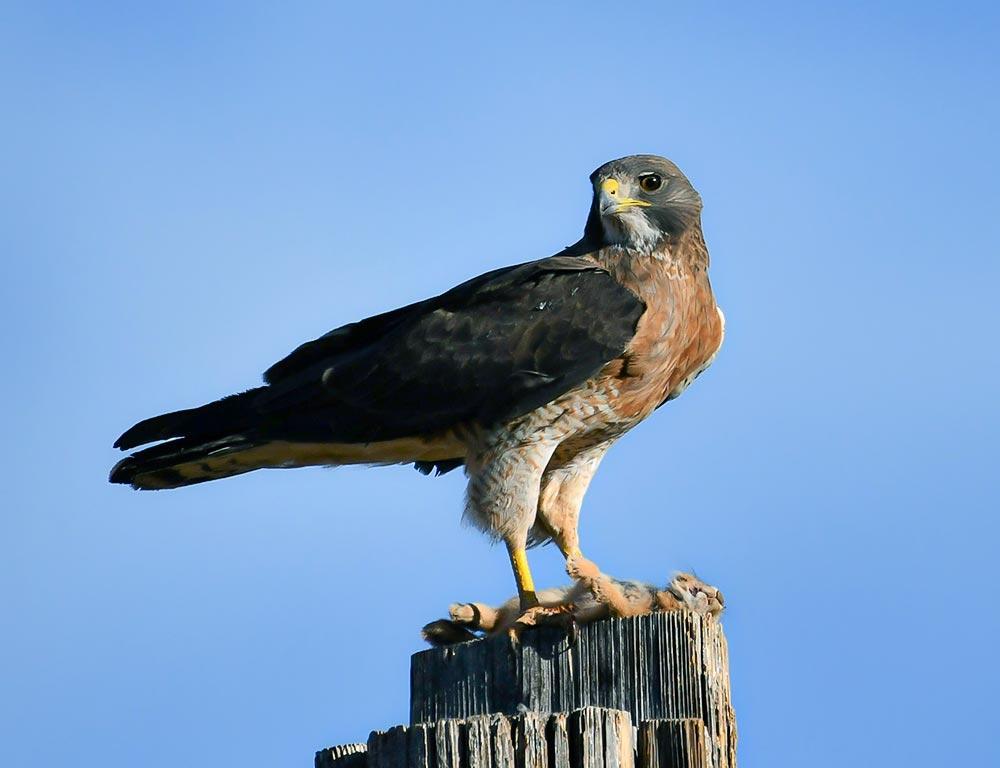
- Scientific name: Buteo swainsoni
- Life span: 7-10 years
- Size: 18-22 inches
- Weight: 1.5-3.5 pounds
- Food: Mainly insects, small mammals, and reptiles
- Wingspan: 45-56 inches
- Status: Uncommon, with localized populations
Swainson’s Hawk (Buteo swainsoni) is a medium-sized buteo known for its migratory behaviour.
During the breeding season, these hawks are found in North America and migrate to South America for the winter. They are occasional visitors to Alabama.
The primary diet of Swainson’s Hawks consists of insects, especially grasshoppers, small mammals, and reptiles.
They hunt by soaring in the sky, using their keen vision to spot prey on the ground. Their nests, constructed with sticks, are typically placed on trees or other elevated structures.
Conservation efforts for Swainson’s Hawks focus on preserving their breeding and wintering habitats. Like many migratory birds, they face threats during their long journeys, including habitat degradation and potential pesticide exposure.
11. Broad-winged Hawk
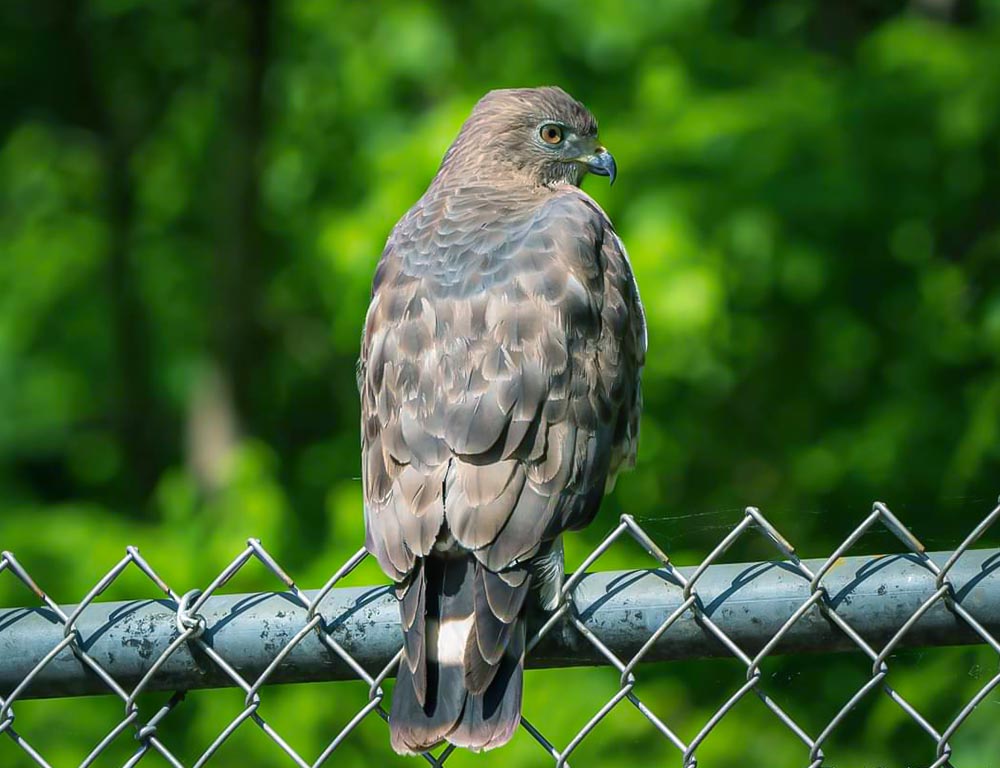
- Scientific name: Buteo platypterus
- Life span: 6-10 years
- Size: 13-17 inches
- Weight: 9-20 ounces
- Food: Mainly small mammals, birds, and insects
- Wingspan: 28-38 inches
- Status: Common, with stable populations
The Broad-winged Hawk (Buteo platypterus) is a medium-sized buteo known for its distinctive plumage and migratory behaviour.
During the breeding season, these hawks are found in the eastern parts of North America, including Alabama, and they embark on an impressive southward migration in large flocks during the fall.
Broad-winged Hawks primarily feed on small mammals, birds, and insects. They are skilled hunters, using their sharp talons to capture prey.
During migration, these hawks are known for their spectacular group flights, or “kettles,” where they ride thermal currents to gain altitude before continuing their journey.
These hawks build nests in deciduous or mixed forests, constructing platforms with sticks and lining them with softer materials. They are generally monogamous and may return to the same nesting site in subsequent years.
While Broad-winged Hawks are common and have stable populations, they face habitat loss and fragmentation threats.
Wrapping Up
In Alabama, a rich tapestry of avian life unfolds against the backdrop of diverse landscapes. Eleven distinct hawk species call this southern state home, elevating the skies with grace and power.
From the iconic Red-tailed Hawk to the elusive Northern Harrier, these raptors embody the essence of Alabama’s wild expanses.
This exploration unveils the remarkable world of 11 Hawks in Alabama, offering insights into their unique features, habitats, and vital roles within the intricate ecological web.
With varying sizes, behaviours, and habitats, these hawks collectively contribute to the dynamic biodiversity of Alabama, showcasing the state’s commitment to preserving its natural heritage.
Join us on a journey through the skies, delving into the lives of these magnificent birds that epitomize the spirit of the Alabama wilderness. Best of luck.